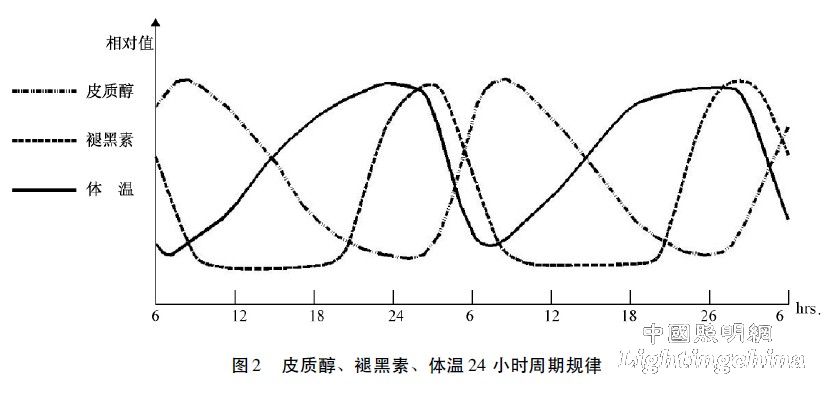1 Introduction
Since the artificial lighting, humans have bid farewell to the sunset, and the life of sunrise can effectively extend the working hours to adapt to the high-speed operation of modern society. At the same time, however, it was found that most people's bodies are in a "sub-health" state [1], showing symptoms such as mental exhaustion, affective disorder, thinking disorder and sleep disorders. Because irregular work violates the 24-hour biological rhythm formed by human evolution. The inherent balance of the human body is broken, the body's immunity is reduced, and it is easy to form various cardiovascular dysfunction-induced cancers and diseases such as Seasonal Affective Disorder (SAD). All of this has attracted the attention of researchers: Light and human circadian rhythms
Is there an inevitable connection?
Human behavioral physiology and other phenomena have adapted to the day and night and seasonal changes caused by the rotation of the Earth during the evolution process. A special organ has been formed in the human body, which has the function of controlling the biological rhythm. It is called the circadian clock. The biological clock of a mammal consists of a mother clock and a clock. The mother clock is located in the hypothalamic supramiasmatic nucleus (SCN), the most important pacemaker in mammalian circadian rhythm organization [2], controlling the body's behavior and circadian rhythm. The sub-clock is located in the peripheral tissues such as the liver and the heart, and receives various regulation from the SCN of the mother clock. The biological clock always accepts the light and dark cycle signals from the outside world and adjusts its own phase to adapt to the external environment. Therefore, to create a healthy lighting environment, we must first understand the impact of light on the human circadian rhythm.
2 The effect of light on the circadian rhythm of the human body
Humans have been studying light for 500 years. For more than 150 years, people have always believed that there are only two photoreceptors with visual effects on human eyes: cones and rods. DeCoursey [3] discovered in 1959 that light had an effect on the circadian rhythm of the human body; Moore [4]'s research team discovered in 1972 another pathway for the eye besides the visual pathway, that is, light is directly projected through the retina onto the optic chiasm. Nuclear (SCN); Until 2002, David Berson of the University of Brown in the United States [5] discovered the third type of photoreceptor cells (translated into Sichen cells), only to find people confused.
How long light produces a "lost link" of photobioeffects through the retinal action of SCN. Yasukouchi et al. in 2005 described two routes for the propagation of optical signals from the retina, as shown in Figure 1. One is the neural channel that transmits the visual image function, and the other is the neural channel that transmits the non-visual information through the suprachiasmatic nucleus (SCN) to link the pineal gland. Light is acting on the pineal gland through non-visual information pathways, affecting the secretion of melatonin. As the recipient of the light signal, melatonin conveys light information from the outside to the relevant tissues and organs of the body, thereby influencing and controlling the internal biological laws of the body, including day and night, seasons and annual rhythms to adapt to changes in the outside world.

Shown. One is the neural channel that transmits the visual image function, and the other is the neural channel that transmits the non-visual information through the suprachiasmatic nucleus (SCN) to link the pineal gland. Light is acting on the pineal gland through non-visual information pathways, affecting the secretion of melatonin. As the recipient of the light signal, melatonin conveys light information from the outside to the relevant tissues and organs of the body, thereby influencing and controlling the internal biological laws of the body, including day and night, seasons and annual rhythms to adapt to changes in the outside world.
2. 1 Effect of melatonin
Melatonin was first introduced in 1958 by Lerner et al. from bovine pineal fruit to fading the skin of frog skin and named Melatonin, a neurogenic endocrine hormone. Under normal physiological conditions, the secretion of melatonin in the human body is more than a few nights, showing fluctuations in circadian rhythm. Moreover, within one day, the secretion of melatonin is usually highest from 1 am to 2 am, until the secretion of melatonin is reduced to a minimum at 12 noon, which is different from the secretion of other hormones in the body, such as cortisol. figure 2. This rhythmic, melatonic, change with the dark cycle is used as a signal of light.
The brain recognizes [6] and regulates the human circadian rhythm and seasonal rhythm. When the human circadian rhythm is broken, the dark cycle changes, and melatonin secretion is abnormal, which will affect the body's physiological functions. It is known that the seasonal changes in light (summer long nights, short winters, long nights) regulate the animal's reproductive system through melatonin [7], and pine nuts are also found in people with abnormal reproductive systems. The body's ability to secrete melatonin is low. In addition, melatonin has a very important regulatory role in the body's immune system, cardiovascular system and antioxidants [8]. Especially in terms of sleep, an appropriate dose of melatonin can alleviate sleep disorders caused by the breaking of the circadian rhythm [9]. Melatonin is also known as "sleep hormone", which controls the body's alertness and sleep.
